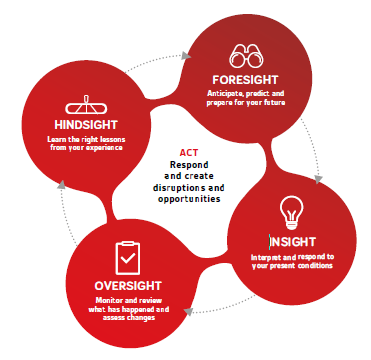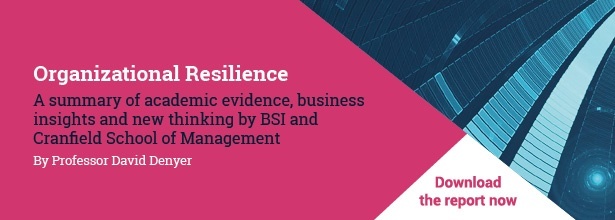 Cranfield methodology to help with large complex problems in times of uncertainty.
Cranfield methodology to help with large complex problems in times of uncertainty.
What did former prime minister Harold Macmillan most fear, a journalist once asked him. “Events, dear boy, events,” he is famously reported to have replied. So too with organisational leadership in general, of course—and in today’s fast-changing business environment, Macmillan’s events seem to be occurring ever more frequently.
Which matters, because one of the core challenges of Organisational Resilience is the ability to quickly mobilise people to meet and respond to these challenges.
Respond too slowly, or incorrectly, and the organisation suffers. Yet responding too quickly also brings dangers—not least due to the often incomplete or contradictory knowledge associated with such challenges, the number of stakeholders and opinions involved, and the interconnected nature of these problems with other issues.
A Cranfield-developed methodology, 4Sight, can help. Moreover, 4Sight is particularly useful for dealing with complex problems involving changing individuals’—or the organisation’s—behaviour, values and priorities, or which are indeterminate in scope and scale.
So if your organisation is wrestling with designing a new software application, developing a new technology, planning a new infrastructure system, implementing a major change programme, or dealing with a crisis, 4Sight may add value that other methodologies can’t.
How, exactly? In short, by complementing the commonly-used, well‑established, but often rigid ‘Plan‑Do‑Check‑Act’ methodology with the flexibility to deal with today’s big, complex issues. As such, 4Sight and ‘Plan‑Do‑Check‑Act’ together offer a structured framework that not only helps organisations meet specific challenges with confidence, but also help them to achieve and sustain organisational resilience.
4Sight: four perspective, four core processes
The similarity between the 4Sight and ‘Plan‑Do‑Check‑Act’ models—both visually, and it terms of functionality—isn’t accidental. Plan‑Do‑Check‑Act’ is a proven methodology, popularised in the 1950s by quality guru Dr W. Edwards Deming, and refined in Japan’s lean production and ‘Six Sigma’ manufacturing environments.
Like ‘Plan‑Do‑Check‑Act’, 4Sight is a repeatable process, but one that involves creative thinking, learning, and insights, rather than implementing known solutions .
It can be thought of as consisting of four core sub-processes, each providing a different perspective: Foresight, Insight, Oversight, and Hindsight. Together, they enable an organisation to respond to—and create—disruptions and opportunities.

Foresight: anticipating, predicting, and preparing for the future
Foresight is about maintaining a constant surveillance for possible opportunities and potential threats, systematically exploring possible, plausible, probable, and preferred futures. As a result, people will be better prepared for uncertainty and change.
Foresight requires an inward focus so people anticipate and notice problems, errors, and issues that could grow into significant incidents—so encourage people to heed the warning signs, and watch for ‘weak signals’ of impending problems. Embrace multiple viewpoints, and listen to diverse voices.
Insight: interpreting and responding to present conditions
Insight is about bringing people together to pause, step back, and see the big picture, helping them consider the interactions between the various parts of the organisation. This involves systematically gathering information and evidence from diverse sources, to continually refine and update the status of ongoing operations and the business environment being faced. In short, it is about building situational awareness.
So search relentlessly for latent problems and errors, and encourage people to report anomalies, mistakes, and concerns—however minor—without fear of retribution, and provide confidence that people’s concerns will be addressed. If required, re-frame or disrupt conventional thinking about solutions by challenging the commonly-accepted understanding of underlying problems.
Oversight: monitoring and reviewing what has happened and assess changes
Oversight is about putting in place a robust process for identifying, prioritising, managing, and monitoring the organisation’s critical risks, and ensure that this process is continually improved as the business environment changes. This involves recognising the organisation’s fallibility, monitoring how closely the system is operating relative to its performance limits, and then managing any deviations as quickly as possible once they have emerged.
To achieve this, the organisation must monitor its performance and track how things are going, as well as understanding the risks inherent in the business model, including key assumptions underlying the continued viability of the mission, together with the business’s risk appetite and tolerance of failure.
Hindsight: learning the right lessons from experience
Finally, Hindsight is about investing time in learning from experience and past events, and understanding that future performance can only be enhanced if the organisation is willing and able to change behaviour as a result of experience.
Importantly, this goes beyond compiling statistics about events, because metrics rarely promote learning by themselves. So avoid the classic ‘blame game’ and asking ‘Who’s fault was it?’, but instead ask questions such as ‘Why did that person act the way that they did at that time?’ This will better help uncover the situational and organisational factors that were involved.
Want to know more?
Read our blog: The latest thinking on Organizational Resilience
There’s a fuller description of 4Sight, as well as insights on how to combine it with the ‘Plan‑Do‑Check‑Act’ methodology, in our report Organizational Resilience: a summary of academic evidence, business insights, and new thinking, which is available for download below.




